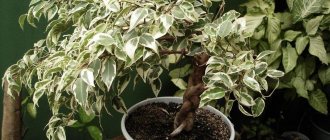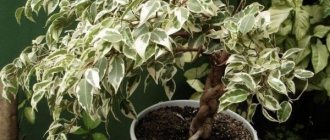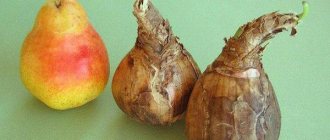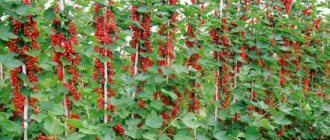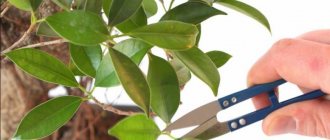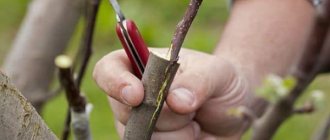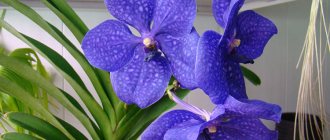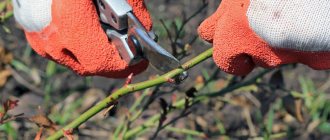"Bon-sai" is a Japanese word that means "planted in a container." The goal of bonsai breeding is to grow a dwarf plant similar to the real thing. Genetically, bonsai trees are not miniature plants; in fact, any type of tree can be grown this way. The most popular dwarf trees are ficus trees. They are quite easy to care for, grow quickly, have branched roots, beautiful unusual bark, small leaves and an impressive trunk. Ficus benjamina bonsai and ficus ginseng bonsai are especially valued.
Which ficus to choose
Shaping a bonsai requires patience and creativity. To make an unusual tree, the plant must have a lush crown, small leaves, a woody stem, branched thick roots, it must bend easily and quickly heal damage.
In the East, coniferous trees are most often used, but a novice plant grower can take ficus. It is well suited for bonsai, as it has the following characteristics:
- This is an evergreen plant that does not completely shed its leaves;
- the leaves are neat, of the same size, brightly colored;
- grows quickly;
- the root system is branched and powerful;
- withstands pruning and quickly heals wounds;
- the stem is strong, with a beautiful pattern and shape;
- the bark is dense, gray or with a beautiful pattern.
To reduce the effort and cost of forming a tree, you need to choose the right ficus variety. Not everyone is equally well suited for this. It is better to take Ficus Benjamin or Microcarp, which is also called Ginseng. They are the most unpretentious and easy to care for.
Benjamin
This variety of ficus grows up to 25 meters in nature. The leaves are bright green, glossy, oval-shaped, forming an umbrella-shaped crown. The bark is dense, dark gray, lined with strokes. Ficus benjamina is unpretentious, grows quickly and is easy to shape.
Microcarpa (Ginseng)
This plant has a spreading crown with dark, wide leaves. The bark is gray, thin. The peculiarity of the ficus Microcarpa is its branched root system. The roots are aerial, powerful, and have an unusual shape.
Why is it important to form a crown?
With the right approach to pruning and creating a beautiful crown, ficus benjamina is always able to unusually decorate the interior , add zest to the room, and create coziness.
The main feature why crown formation is necessary is the thin, long branches of the flower, hollow inside at the base. They can reach a length of up to 2 meters. Therefore, over time they begin to bend under their own weight, which looks rather sloppy and unkempt.
The formation of the crown will include several stages that will help the plant grow well in the future:
- inspection for the presence of dry branches;
- removal of weak, lifeless processes;
- pruning wrinkled branches to the beginning of the living place;
- topping;
- removal of stepsons, which in the future will only interfere and disrupt the beauty of the flower.
Important! Don't be afraid to trim off excess length. If the branch is thin and long, then shortening it will only be beneficial.
Over time, the ficus benjamina gets used to being looked after and pruned. He likes it because he begins to sprout new green leaves faster, the crown looks thicker and more beautiful.
Types of bonsai
Forming a miniature tree is an art. A creative approach is needed, then the bonsai will turn out original. But there are several general trends. You need to determine in advance what shape the bonsai will be. It can be formed by cutting branches, roots, and bending the trunk. Traditional bonsai has the following forms:
- tekkan – straight trunk, fewer branches on top, shape reminiscent of a Christmas tree;
- moyogi – the trunk is bent in several places, there are many branches, they are directed in different directions;
- shakan - the crown is tilted to the side at an angle of 60-80˚, the leaves are only on top, the roots are strongly turned out;
- sokan – two trunks arise from one root;
- hokidati - the crown expands upward;
- esueue – at least 5 trees of different ages and even varieties grow in one pot.
For a beginner, it is better to choose tekkan - the easiest bonsai to form and care for. The most difficult thing is hokidachi. Although the shape seems simple, it is difficult to find the balance of the branches.
How to choose a shape to create a tree
Traditional Japanese styles are used to form ficus benjamina bonsai:
- Tekkan. The straight formal style is suitable for beginners. A plant formed in this way can be recognized by its straight trunk with thick visible roots and the pyramidal shape of the crown.
- Moegi. The straight informal style is distinguished by a trunk bent in 2-3 places and a straight top perpendicular to the ground. This shape imitates a tree grown in the wild.
- Yose Ue. The group style symbolizes the creation of a grove. Several plants are planted in one pot. Traditionally, the Japanese prefer an even number of plants (except 4) of different heights.
- Syakan. The slanted style means wind resistance. The trunk deviates from the vertical, the roots on the opposite side of the slope protrude above the ground, which should be associated with a tree torn out by a storm.
- Sokan. The double trunk reveals the image of parent and child. A plant grown in this style has a common crown and roots.
- Hokidachi. The broom style requires the wood to be symmetrical. From a straight trunk, branches diverge in all directions, the crown is spherical in shape.
Bonsai styles.
How to grow a bonsai from a ficus at home
This unpretentious plant is great for bonsai. You can form a miniature tree of a bizarre shape in 2-3 years. Even with no experience, you can get a small tree 20-30 cm in height from a tall plant. Once the ficus variety and the shape of the future bonsai have been chosen, you need to choose the right everything for growing it.
How to choose a pot
The most important thing is the pot, which should be different from that of ordinary indoor plants. The word "bonsai" is translated from Chinese as "grown on a tray." The pot should be flat, 4-5 cm deep. Wide, rectangular or round. The main condition is a lot of drainage holes. Such pots have legs up to 10 cm high.
If the container is deep, the roots will grow greatly. Because of this, it will not be possible to avoid the growth of the crown; the plant may stretch in height.
What kind of soil is needed
The soil for bonsai is selected specially; the soil should be light and well-permeable to air. Granular clay is most often used. You can buy soil for palm trees, ficus trees, mulberries and add sand 3:1. Or make your own potting mix. It consists of the following parts:
- coarse sand, peat, powder clay in equal quantities;
- 6 parts leaf soil, 4 parts small pebbles, 2 parts perlite and 1 part humus;
- clay powder, coarse sand, humus 6:3:1, add 10% crushed pine bark to the mixture.
Planting ficus for bonsai
You can purchase ready-made bonsai in the store. If transplantation is necessary, you need to allow the plant to adapt to new conditions. It can be transplanted into another pot after 10-15 days. But most often bonsai are made from an ordinary plant. It's not difficult, but for the first time it's better to use a step-by-step guide.
- Cut off the top of the ficus, 8 to 12 cm long. The cutting should have 3-5 leaves and at least one growth point. Sprinkle the cut with crushed activated carbon and dry it for a couple of hours.
- Place the cuttings in water, or even better, in a solution of any growth stimulant. The jar should be in the light, the temperature should not be lower than 25°. It is advisable that it be heated from below.
- When the roots form, you need to prepare the pot. Place a mesh on the bottom to cover the drainage holes. Pour sand onto it, and then the selected soil.
- Find a small round stone. Place it in the middle, place the cutting on it, spreading the roots along it. Sprinkle with soil and tamp down a little. You can plant several cuttings in one pot, then they can be intertwined.
- Water the plant well. After half an hour, drain the water from the pan.
- The plant will take root in 3-4 months. At this time, you can begin to gradually expose the roots.
- You can start pruning and shaping the crown in six months.
Weaving the trunk of ficus benjamina
Spiral
This is the most common type of ficus Benjamin weaving. The reason for the popularity of this method lies in its simplicity and small number of sprouts. Two sprouts are enough, but with three the weaving will look more decorative. Young ficuses should be the same length, about 15 cm. Their trunks should be no more than half lignified. In most cases, a strong support is enough for the flower trunks, around which the stems weave clockwise. The most important thing is to remove side shoots and guide the plant in time. When the spiral of stems reaches the desired height, the support can be removed from the pot, and the flower will delight with its intertwined trunk. In some cases, a spiral can be made from 4 shoots, but with such a trunk there will be more trouble.
This may be interesting: Selaginella (Plaunok) - an ancient plant in your home
Pigtail
To give the trunk this unusual shape, three or four ficus seedlings of the same length, about 13 cm, and thickness from one to one and a half cm should be planted in one pot at once. This length will already be enough to start braiding. If the thickness of the stems is less than one cm, wait a while with weaving.
First, remove all side branches from the stems, leaving only the tops. Now water the soil in the pot well to make the stems more flexible. If you watered the plant in the evening, you can start weaving in the morning, i.e. The plant should remain watered for at least 10 hours. Then the trunks of young, well-watered ficus trees will easily lend themselves to weaving. But this is not like braiding your granddaughter’s hair before school. You will have to weave this braid for a long time, more than one month, in parts. The first time you will be able to make several turns. But the stems grow slowly, and you will make each next turn as they grow, cutting off the side shoots that appear from them.
The braided part of the trunks must be tied with a soft woolen thread so that they do not unravel. You can adjust the weaving force yourself. If you weave a little looser, gaps will appear between the stems. Insert into them, for example, sticks of the same thickness. Then you will remove these shelves. We assure you that adult ficus specimens will look very decorative. But this will not happen soon. In the meantime, the thread will need to be rewound every month so that it does not grow into the bark. If the weaving was tight, then during rewinding you may see droplets of white milky juice, which indicates damage to the bark. It's okay, the wounds will heal. And yet, make the next harness a little weaker.
The trunks must be tied with threads strictly at an angle of 45 degrees. If your ficus braid is tall enough, we recommend installing a support. Although, usually in this form, with an intertwined stem, the flower holds well in an upright position and does not need support.
Watch the video on how to braid ficus benjamina:
Column (splicing of trunks)
If you want all the stems of your trunks (from 3 to 5 pieces) to grow together into one, you need to carefully remove the bark from the seedlings in small parts at the joints. The trunks should have no side branches, only green tops. Secure the joints with soft thread or wire. Approximately, the trunks will grow together after five to six months. To prevent the thread or wire from growing into the bark, change it every month. The tree will turn out to be very original, with one but unusual trunk.
Lattice
You will need eight seedlings (classic lattice), but sometimes fewer are used if it is not possible to purchase a sufficiently voluminous planting container. The main thing is that their number must be even. Plant your seedlings in one line at the same distance from each other (this is a prerequisite). The sprouts should be the same length and width, not yet lignified. After some time, the seedlings will begin to grow and develop. Wait until the ficus grows to a height of 10 -13 cm and begin to form a green lattice. Take a cardboard pipe and insert it into the middle, thereby crossing all adjacent trunks. Guide them to the desired position using polyethylene or coiled wire. Remember to periodically loosen the clamps to avoid damaging the bark and branches.
The lattice may not be perfectly straight; it may have a curve that will give your design individuality and its own charm.
To better understand the process of weaving ficus benjamina in the form of a lattice, we recommend watching the videos below:
Circular weaving
Circular weaving is done in the same way as lattice weaving, only the sprouts are planted not in one line but in a circle or square. The video clearly shows how to properly plant and intertwine cuttings.
Sometimes circular weaving is created in a different way, using a coconut stem, which is installed in the center of the flowerpot. In this case, seedlings are planted around this trunk at a short distance from it. The side shoots of the sprouts are removed. Considering the fact that the coconut trunk has high humidity, the aerial roots of the ficus will begin to actively develop and intertwine with each other, creating an unusual composition that looks like a vase. If there is no coconut trunk, use a homemade tube made of thick cardboard. To direct the stems and branches in the direction you want, feel free to use a soft thread or insulated thin wire, just do not over-tighten the shoots so as not to damage the ficus. Then both the wire and thread must be carefully removed from the plant.
This may be interesting: How to overcome the difficulties of caring for Poliscias
Bonsai formation
After proper planting and rooting of the plant, you need to start shaping it so that the ficus takes the desired shape and takes on the appearance of a bonsai; it is tied up, bent, tilted, and trimmed.
Roots
When planting the plant, the neck of the root should be at ground level. After 4 months, the formation of roots begins, and the soil is gradually raked away from them. They thicken, become rough, and take on a bizarre shape. Ficus Microcarpa has especially beautiful aerial roots.
Trunk
You can create the desired shape of the trunk using a garter with rope or wire. It is better to use a rope, it damages the bark less. The plant is carefully tilted in the desired direction and tied to a support or base of the tree. You can use a wire structure for this. Be sure to place a cloth under it or use an insulated wire. The branch or trunk with the wire is carefully bent and given a certain shape. After 2 months it is removed by cutting it with pliers.
Crown
To form a crown, it needs to be trimmed. This is done when the tree has grown to the desired height, usually in spring or summer. After pruning, it will begin to grow in width. It is recommended to cut the branch with half the leaves. Trimming starts from the bottom. This stimulates the formation of a thick crown; the cut areas should be sprinkled with coal.
Proper care
In order for ficus to grow well and be shaped at home, it needs to be created with favorable conditions. A small tree needs the same care as a regular ficus. There are several conditions that must be met.
- You need to place the bonsai pot in a well-lit place, but not in direct sunlight. It is advisable that there be at least 12 hours of daylight. If necessary, in spring and summer the plant is illuminated.
- Bonsai does not tolerate changing conditions; you need to immediately determine a permanent place. There should be no drafts, the temperature should be 18-25˚. It is undesirable to place the plant next to a heating radiator; it will be damaged by hot air flows and low humidity, and if there are sudden temperature changes, the tree may die.
- In summer, the plant needs to be watered daily. In winter, less often, but spray the crown between waterings. Use settled water for irrigation.
- In order for bonsai to form aerial roots, you need to humidify the air in the room.
- In spring and summer, fertilizing is carried out twice a month. Liquid fertilizers with nitrogen, phosphorus and potassium are best. Can be used organic or for ficus and palm trees. They are brought into the ground, but not on the roots.
- Young trees up to 5 years old are replanted every 2 years. During the replanting process, the roots are cut by a third.
Selecting soil and pot for growing
The pot for growing bonsai is not like the usual flower pot. It looks more like a pallet with low sides on legs. The legs should not be low, about 10-15 cm. Holes in the pot are also necessary. Their diameter must be at least 1 cm.
The soil for bonsai, oddly enough, should not be very fertile. For this plant, the most suitable substrate is one that allows moisture and air to pass through well, for example red clay in granules. It can be purchased in specialized stores. You can also prepare the soil at home yourself.
The nuances of growing ficus bonsai
This plant is ideal for growing bonsai at home. But for such a tree to turn out beautiful, you need to know its features.
- This tree often grows in rocky soil, with roots adapted to the lack of soil. You can use this in bonsai; aerial roots look original.
- Stones can be used, but they must be rough, with cracks on which the plant can get caught. Before laying the stone, it must be coated with a mixture of soil and clay to strengthen it.
- It is best to form the desired shape by trimming. Ficus shoots are fragile and break easily. Wire can be used when you already have experience.
- The roots do not need to be covered from above, they should be visible.
- Ficus Microcarpa or Ginsenga sheds its leaves every 2-3 years.
Possible problems and errors
Growing bonsai is more difficult than ordinary ficus. A small tree can quickly die if not properly cared for. Therefore, you need to carefully monitor it and, if necessary, take immediate action. Several problems may arise.
- When the leaves darken, gray spots appear on them and on the trunk, and moss appears on the soil - this may indicate excess moisture. You need to water the plant less often, waiting until the soil dries. Don’t forget to drain the water from the pan half an hour after watering.
- If mold appears, the plant will have to be replanted. All soil is removed, the roots need to be washed and damaged ones removed. Then the ficus is planted in a new place and sprayed with a 1% fungicide solution.
- The leaves lighten, become limp, the bark becomes covered with folds - this means the plant does not have enough moisture. It needs to be watered more often and the air humidity should be increased.
- Almost all the leaves have fallen off - the plant is in a draft or there is not enough light. This can happen if you water your bonsai with too cold water.
- The leaves begin to curl, the tips dry out - this happens from bright sunlight. You need to either move the pot or shade it during the day.
Growing ficus bonsai is not difficult. This plant is unpretentious, flexible, and even a beginner can cope with the formation of the crown. If you show patience and imagination, and also follow the rules of care, the ficus will delight you with its unusual shape and bright greenery.
